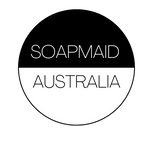
The Chemistry of Olive Oil Grades in Soapmaking: Extra Virgin vs Virgin vs Pomace
The Chemistry of Olive Oil Grades in Soapmaking: Extra Virgin vs Virgin vs Pomace
Why pomace traces in seconds while EVOO takes minutes — the science of FFA, antioxidants, and fatty acids

Olive oil is the heart of gentle, conditioning soap — but not all grades behave the same in the pot. Pomace can seize in seconds, virgin accelerates quickly, while extra virgin (EVOO) stays fluid for swirls. The difference? Chemistry. This Australian soapmaker’s guide explains the science of free fatty acids (FFA), antioxidants, and saponification speed — with practical tips for each grade.
Understanding Olive Oil Grades
| Grade | Extraction | FFA % | Antioxidants | Trace Speed |
|---|---|---|---|---|
| EVOO | Cold-press, no heat | ≤0.8% | High (polyphenols) | Slow |
| Virgin | Cold-press, lower quality | ≤2.0% | Moderate | Medium |
| Pomace | Heat + solvent | High (pre-refine) | Very low | Very Fast |

Why Trace Speed Varies: The Science
1. Free Fatty Acids (FFA)
FFA = pre-reacted soap molecules. They react instantly with NaOH → immediate emulsification.
- EVOO: 0.3–0.8% FFA → slow start
- Virgin: 0.8–2.0% → moderate acceleration
- Pomace: 3–10% pre-refine → lightning trace
2. Fatty Acid Profile
Oleic acid (C18:1) saponifies slowly. Palmitic/stearic speed it up.
- EVOO: 75% oleic → fluid batter
- Pomace: Higher saturated fats → faster thickening
3. Antioxidants & Unsaponifiables
Polyphenols in EVOO buffer the reaction — like natural emulsifiers in reverse.
- EVOO: 200–500 ppm polyphenols
- Pomace: <50 ppm → no resistance
Key Insight: Pomace trace = FFA surge. EVOO trace = gradual saponification.

Tips for Working with Each Grade
Extra Virgin Olive Oil (EVOO)
- Best for: Swirls, layers, Castile
- Temp: 35–40°C
- Water: Full or slight discount
- Fragrance: Any (even accelerators)
Virgin Olive Oil
- Trace: Medium-fast
-
Slow it down:
- Soap at 30–35°C
- Use full water
- Hand-stir after emulsion
- Avoid spice/citrus FO
Pomace Olive Oil
- Trace: Lightning (30 sec–2 min)
-
Manage it:
- Work at 25–30°C
- Add FO after light trace
- Keep designs simple
- Blend with high oleic sunflower (20%) to slow
Pro Tip: Test trace with a spoon drizzle — if it holds shape, you’re at medium trace.
Shop Olive Oil from Soapmaid
Australian Virgin Victorian Stock
Australian Virgin Victorian Stock
